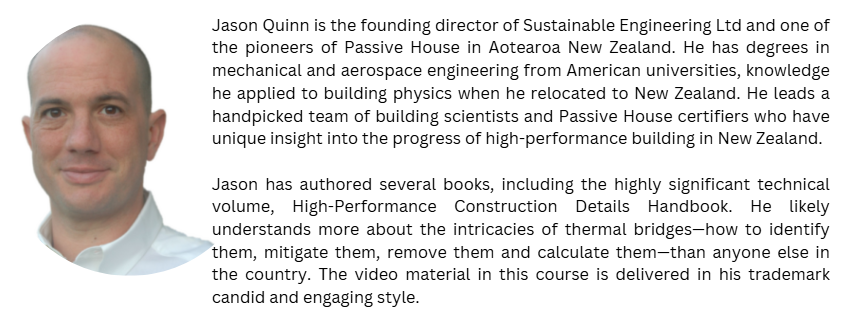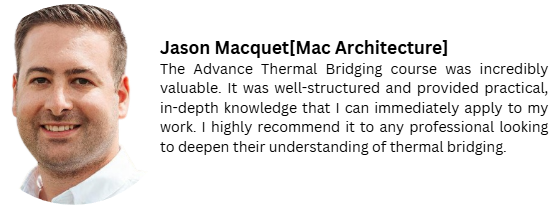
Avoiding or minimising thermal bridging is a key pillar of Passive House design and a vital skill for a Passive House designer or architect. Not all thermal bridges need to be modelled. The High-Performance Construction Details Handbook contains dozens of proven details with the values already calculated; there are even CAD drawings available for download.
It’s not hard to draw a novel thermal bridge using software like THERM or Flixo. The important bit is understanding what to draw and when it’s necessary. The team at Sustainable Engineering, New Zealand’s Passive House certifiers, created this very tailored course in order to address this specific knowledge gap.
This course is designed for newly qualified Passive House designers who want to start modelling non-standard thermal bridges for their projects. This gives more scope for bespoke architectural details or non-standard materials.
In Their Own Words
Essential prerequisites
This course is for certified Passive House designers or consultants, for example the CEPH course taught by PHANZ. This qualification is an essential prerequisite for enrolling in this Advanced Thermal Bridging course. Those designers who have gained their qualification via the certification of a successful Passive House project will need to demonstrate sufficient theoretical understanding of thermal bridges before their enrollment is approved. This course is ideally suited to those who already have some experience in modelling basic thermal bridges in THERM or Flixo. Certified Passive House designers or consultants without any modelling experience may find that some additional coaching is needed.
Overall course outcome
After successfully completing this course, participants will have a more thorough understanding of the concept of thermal bridges and will be able to confidently model moderately complex non-standard thermal bridges details for the purpose of Passive House certification.
Course structure
The course is designed to make it as accessible as possible for busy professionals and to remove the costs and logistics associated with travel, accommodation and a block of time off work. It is taught solely on-line and can be accessed via Sustainable Engineering Ltd’s learning platform, which uses Moodle.
The course involves more than 40 sessions. The course can be undertaken at any time that suits the individual and completed at their pace (although there is a maximum six-month time frame to keep students focused). The course also includes quizzes and homework to reinforce student learning. Additional coaching, should it be necessary, can be booked at standard consulting rates.
Investment
The course fee of $552 (ex GST) is due seven days prior to the course starting. We recommend participants allocate one hour for additional study per hour of video. Participants will get the most benefit by undertaking the study when they have sufficient time to study in a focused, consistent way. All up, we expect it would take a typical student six to eight hours to complete all the course requirements.
There will be no refunds once the course has been accessed so it is important that students understand the prerequisites and what is expected of them. This course assumes participants have basic computer skills and an understanding of thermal bridge theory, such as is taught during the CEPH course.
Copyright
The course materials including videos represent a significant investment in intellectual property. All materials are copyright and may not be accessed by any one other than the course participant.
Detailed outline
There are over 40 videos, offering a total of one hour and 20 minutes of material. The video was recorded when the course was delivered live to a previous cohort of students. It has since been edited to suit self-paced online delivery. The course also includes access to reference materials, including THERM and Flixo files, and homework/practice materials.
The following learning outcomes are expected, under two broad headings.
What to draw
- Understand the thermal bridge concept and the outputs available from a heat flow calculation.
- Set up a thermal bridge calculation for specific connection details; understand the PHI and PHPP fundamental concepts necessary for calculating window connections and ground connection details.
- Understand the standards used to set-up thermal bridge calculations and why it’s necessary to read the official standards.
- Know the correct boundary conditions to be used in Psi-values and fRsi values.
- Familiar with fRsi limits and changes in PHPP 10.
- Able to use worksheets to calculate Psi-values and fRsi values from details with known dimensions, component qualities and heat flow results
When it’s necessary to draw thermal bridges
- Confidently determine whether a connection detail requires a thermal bridge calculation or not.
- Knowledge of how to reduce heat losses by thermal bridge connections (linear and punctual).
- Confidently use an atlas to develop an understanding of the typical ranges of thermal bridge coefficients for assemblies.
- Know where on a building to look for and count thermal bridges.
Note that a number of example details modelled in thermal bridge software will be provided to students.
Your instructor


